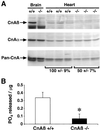Impaired cardiac hypertrophic response in Calcineurin Abeta -deficient mice
- PMID: 11904392
- PMCID: PMC123691
- DOI: 10.1073/pnas.072647999
Impaired cardiac hypertrophic response in Calcineurin Abeta -deficient mice
Abstract
Calcineurin is a calcium-calmodulin-regulated, serine-threonine phosphatase that functions as a key inducer of stress responsive gene expression in multiple cell types through a direct activation of nuclear factor of activated T cells and myocyte enhancer factor 2 transcription factors. In cardiomyocytes, calcineurin signaling has been implicated in the regulation of the hypertrophic response caused by pressure overload or neuroendocrine stimulation. Three separate genes encode the catalytic subunit of calcineurin in mammalian cells, CnAalpha, CnAbeta, and CnAgamma. To evaluate the necessary function of calcineurin as a hypertrophic regulatory factor, the CnAbeta gene was disrupted in the mouse. CnAbeta-deficient mice were viable, fertile, and overtly normal well into adulthood, but displayed a 80% decrease in calcineurin enzymatic activity in the heart that was associated with a 12% reduction in basal heart size. CnAbeta-deficient mice were dramatically impaired in their ability to mount a productive hypertrophic response induced by pressure overload, angiotensin II infusion, or isoproterenol infusion. Analysis of marker genes associated with the hypertrophic response revealed a partial defect in the molecular program of hypertrophy. Collectively, these data solidify the hypothesis that calcineurin functions as a central regulator of the cardiac hypertrophic growth response in vivo.
Figures





References
-
- Crabtree G R. Cell. 1999;96:611–614. - PubMed
-
- Klee C B, Ren H, Wang X. J Biol Chem. 1998;273:13367–13370. - PubMed
-
- Rusnak F, Mertz P. Physiol Rev. 2000;80:1483–1521. - PubMed
-
- Haq S, Choukroun G, Lim H, Tymitz K M, del Monte F, Gwathmey J, Grazette L, Michael A, Hajjar R, Force T, Molkentin J D. Circulation. 2001;103:670–677. - PubMed
Publication types
MeSH terms
Substances
Grants and funding
LinkOut - more resources
Full Text Sources
Other Literature Sources
Molecular Biology Databases
Research Materials

